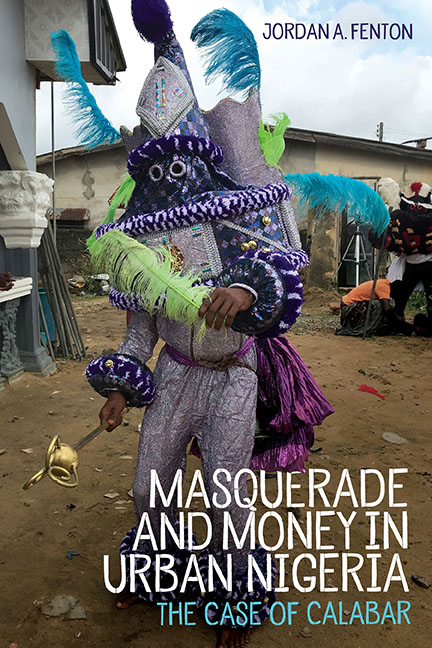Chapter Five - “Idagha Chieftaincy Was Nothing Like What it is Today”: The Spectacle of Public Performance
Published online by Cambridge University Press: 26 May 2022
Summary
On a Saturday afternoon in December 2009, the streets of a section of Calabar were overtaken with an expressive explosion of excitement as an Ekpe procession publicly took to the streets (Figure 5.1). As usual with this type of performance, something city dwellers often encounter multiple times a year, Efik Ekpe members strolled at a pace to their liking, singing and rejoicing, publicly celebrating the installation of a member to the rank of chief or titleholder of the society. All members were decked out in the latest chieftaincy fashions, some locally produced while most were imported: flat or “ivy” caps, walking sticks, damask and nkisi wrappers, and long shirts of colorful eyelet embroidery and cotton manufacture. Behind the chiefs, lesser members filed behind with drummers situated at the back of the procession, each dressed in long white shirts of rayon and cotton with wax-print wrappers neatly tied around their waists. Outfitted in my chieftaincy garb, as I scrambled to document and photograph the multimedia spectacle as it poured into the streets, thoughts of my own public Mgbe chieftaincy rite performance engulfed my mind.
Although I have documented and participated in eleven Ekpe/Mgbe chieftaincy installations, this was the first since becoming an Ekpe/Mgbe chief; with such experiences and knowledge fresh on my mind, I was much more attuned to the ways in which the expressive currencies of dress, structured procession, music, and masquerades facilitated a spatial dialogue between members and the growing crowd, who overwhelmingly paused their daily grind to witness and remark on the pageantry as it passed by. The major ingredients crystalizing the dialogue that day were four masquerade characters moving in tandem with the marching members. Two of the masquerades’ costumes were made mostly from raffia, a local material. The other, Ebonko with its cloth manufacture, dramatically contrasted the natural raffia masquerades. Ebonko was a visual beacon for onlookers with its aesthetic based on global imports, a curious composition that those unfamiliar with Ekpe/Mgbe might not expect to see from a long-standing West African secret society (Figure 5.2).
The visual and performative elements of Ekpe/Mgbe chieftaincy, primarily with dress and masquerade ensembles, stimulate multiple ideas and historical reflections.
- Type
- Chapter
- Information
- Masquerade and Money in Urban NigeriaThe Case of Calabar, pp. 150 - 198Publisher: Boydell & BrewerPrint publication year: 2022



